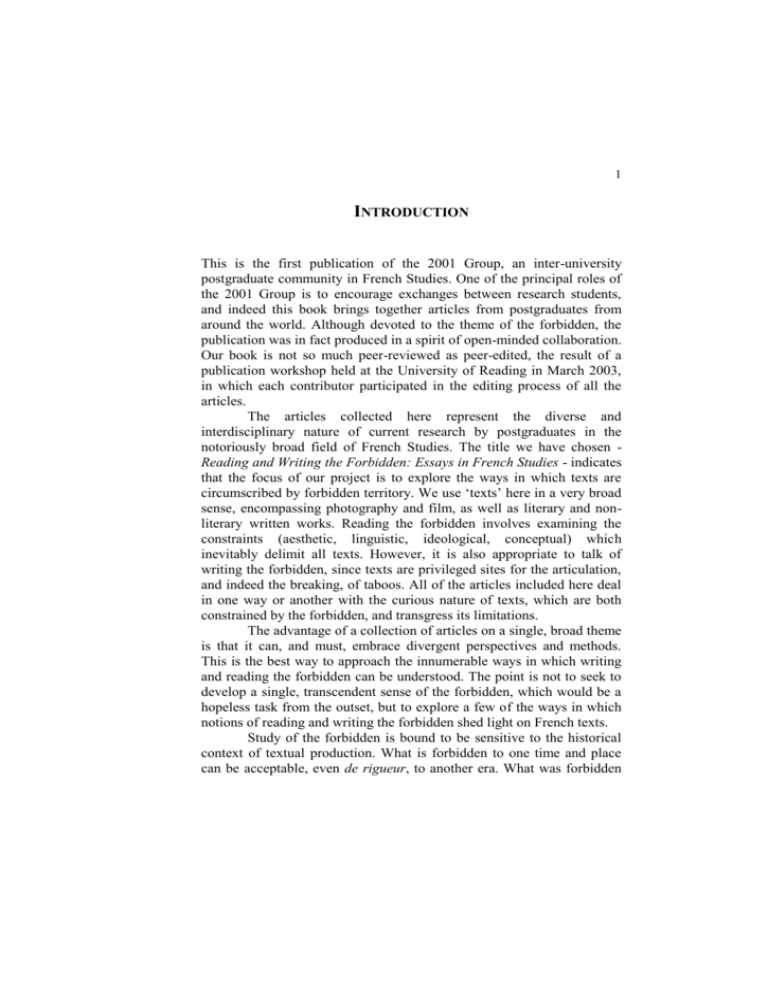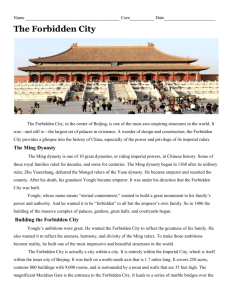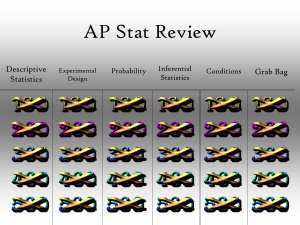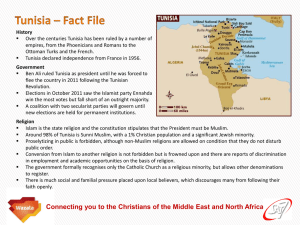Introduction - University of Reading
advertisement

1 INTRODUCTION This is the first publication of the 2001 Group, an inter-university postgraduate community in French Studies. One of the principal roles of the 2001 Group is to encourage exchanges between research students, and indeed this book brings together articles from postgraduates from around the world. Although devoted to the theme of the forbidden, the publication was in fact produced in a spirit of open-minded collaboration. Our book is not so much peer-reviewed as peer-edited, the result of a publication workshop held at the University of Reading in March 2003, in which each contributor participated in the editing process of all the articles. The articles collected here represent the diverse and interdisciplinary nature of current research by postgraduates in the notoriously broad field of French Studies. The title we have chosen Reading and Writing the Forbidden: Essays in French Studies - indicates that the focus of our project is to explore the ways in which texts are circumscribed by forbidden territory. We use ‘texts’ here in a very broad sense, encompassing photography and film, as well as literary and nonliterary written works. Reading the forbidden involves examining the constraints (aesthetic, linguistic, ideological, conceptual) which inevitably delimit all texts. However, it is also appropriate to talk of writing the forbidden, since texts are privileged sites for the articulation, and indeed the breaking, of taboos. All of the articles included here deal in one way or another with the curious nature of texts, which are both constrained by the forbidden, and transgress its limitations. The advantage of a collection of articles on a single, broad theme is that it can, and must, embrace divergent perspectives and methods. This is the best way to approach the innumerable ways in which writing and reading the forbidden can be understood. The point is not to seek to develop a single, transcendent sense of the forbidden, which would be a hopeless task from the outset, but to explore a few of the ways in which notions of reading and writing the forbidden shed light on French texts. Study of the forbidden is bound to be sensitive to the historical context of textual production. What is forbidden to one time and place can be acceptable, even de rigueur, to another era. What was forbidden 2 in the distant past may seem more easily recognizable than what is forbidden to us now. Nonetheless, in their conscious and unconscious articulation of what was forbidden to them, texts from the past are necessarily foreign to us. The fact that the category of the forbidden in past texts is both deceptively easy to identify and inevitably strange accounts for the large number of articles on early modern literature here, which make up almost half of the contributions to our book, and all of Part I. Julia Horn’s article explores how the immense sixteenth-century chivalric romance, Amadis de Gaule, is bound by generic limitations which mean that certain events, particularly the death of the hero, are forbidden in the narrative. While Horn reads the forbidden in Amadis, Hugh Roberts looks at how early modern texts write the forbidden, through reference to the distant pagan past of the Cynics. The scandalous truth-telling of these ancient philosophers is used by writers, including Montaigne, to open up difficult and dangerous ideas. Marilyn Cox examines the ways in which Jean-Pierre Camus seeks to contain the forbidden acts described in his narration of horrifying histoires tragiques within a moralizing discourse, which sometimes seems to protest too much. The capacity of texts to broach material and ideas they expressly condemn is also explored by Ann Lewis, who argues that La Nouvelle Héloïse contains within it the seeds of a forbidden reverse-reading, which would have had Rousseau turning in his grave. Probably the most wantonly outrageous text examined here is the Erotika Biblion of the eighteenth-century libertin, Mirabeau. Isabelle Dotan-Robinet analyses the philosophical criteria that lie behind Mirabeau’s defiance of taboos, and how his essay falls into both incoherence and unconscious expression of prejudice. Plainly, however, the realm of the forbidden is not restricted to early modern texts. Part II focuses on how the forbidden is framed and frames photography and cinema. What should or should not be depicted on film is in an obvious sense a uniquely modern phenomenon. Nonetheless, revealing connections between text and image are as old as writing itself. The ways in which juxtapositions of text and image can illuminate the forbidden is an underlying theme of articles on such diverse texts as Rousseau’s La Nouvelle Héloïse, the works of Pierre Loti, and the nineteenth-century right-wing political press in Paris. The latter’s representation of the Commune, the memory of which it sought to 3 mythologize and suppress, is the subject of Colette Wilson’s contribution. Catherine Guy-Murrell draws on Barthes’s writings on photography to illuminate the broaching of aesthetic and cultural taboos in photographing of veiled women in the twentieth and twenty-first centuries. The starting point of Libby Saxton’s article is that the real is in a sense forbidden in filmic (and indeed textual) representation. However, Saxton argues that what is ontologically forbidden to film implies that some types of cinematic representation should be ethically forbidden. Part III concentrates on the themes of transgression and marginalization in modern French literature. As Morag Young argues in her article, these two concepts are linked, since the transgressive person is invariably marginal. Using insights drawn from psychoanalysis, Peter Turberfield argues that Pierre Loti’s apparently exploitative, and ostensibly forbidden, sexual treatment of ‘Oriental’ dress and individuals symbolically reverses the power relations between colonizer and colonized. Victoria Reid investigates how Gide tries to have his forbidden fruit and eat it by seeking to displace his transgressive sexuality onto predatory women. Joanna Shearer uses Kristeva’s arguments concerning the ‘abject’ nature of women’s bodies to provide a means of approaching Simone de Beauvoir’s Le Sang des autres. Morag Young looks at how both literal and metaphorical border-crossing sheds light on the quest for identity as expressed in the novels of Duras, Modiano, and Darrieussecq. The search for identity both within and outside the constraints of the forbidden is a recurrent theme in the articles of Part III, whether it is Loti’s search for a self through transvestism, Gide’s exploration of his sexuality, or Beauvoir’s attempt to frame the female body. The ways in which selves are fashioned with reference to forbidden frontiers mirrors the way in which texts are both constrained by, and transgress, the limits of the forbidden. While our book is most obviously relevant to specialists in each of the areas covered by its three parts, it would also reward the reader on the look out for unexpected connections between articles devoted to very diverse subject-matter. Nothing is forbidden to the reader who is happy to see Rousseau rub shoulders with transvestites, Simone de Beauvoir in close company with macho eighteenth-century libertines, and The Matrix alongside Rabelais. For each of the contributors, writing the forbidden was a great opportunity to exchange ideas and to participate in unfamiliar 4 areas of French Studies. Now we can only hope that reading the forbidden proves as enjoyable, informative, and liberating as writing the forbidden. Hugh Roberts




